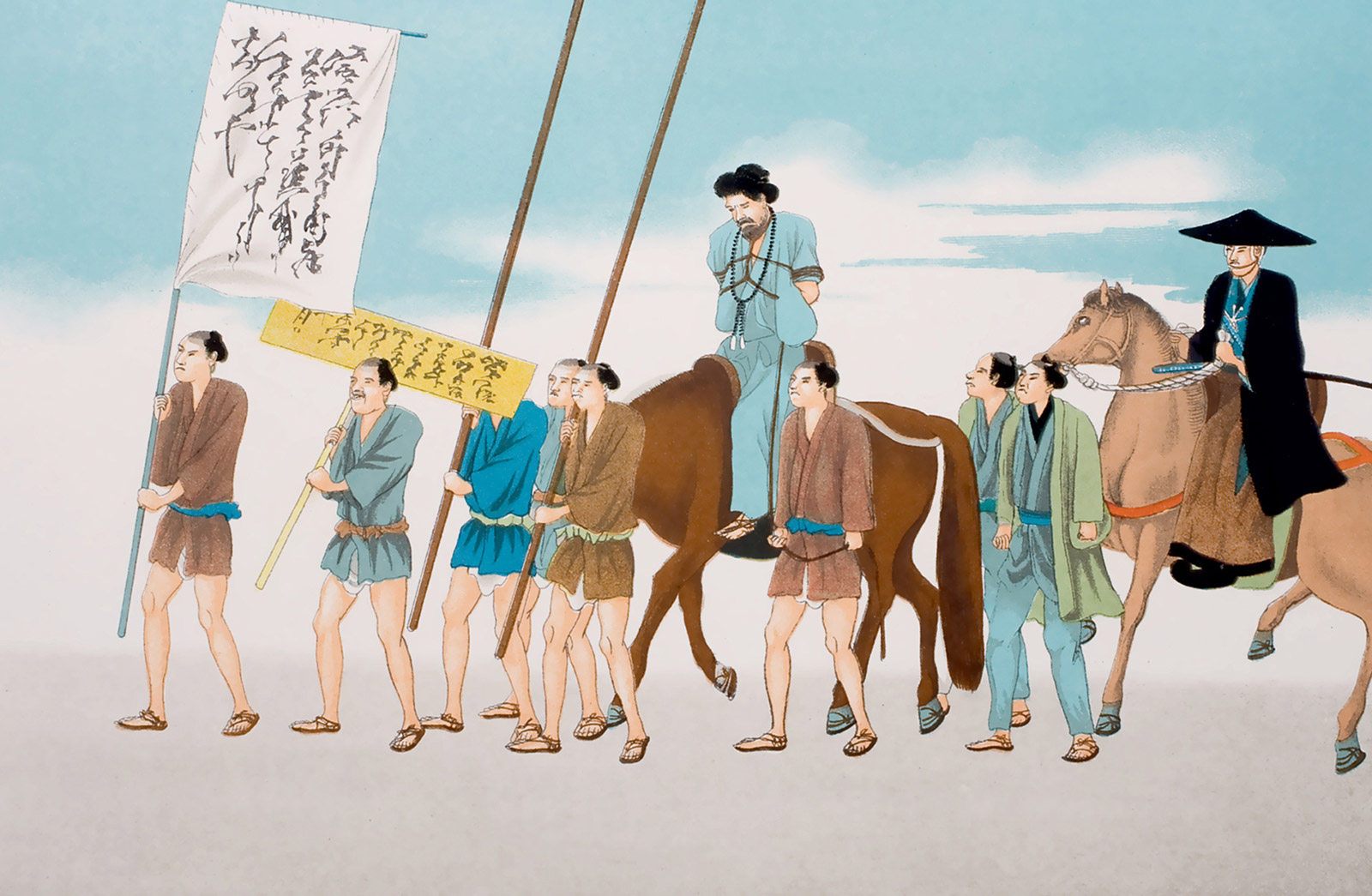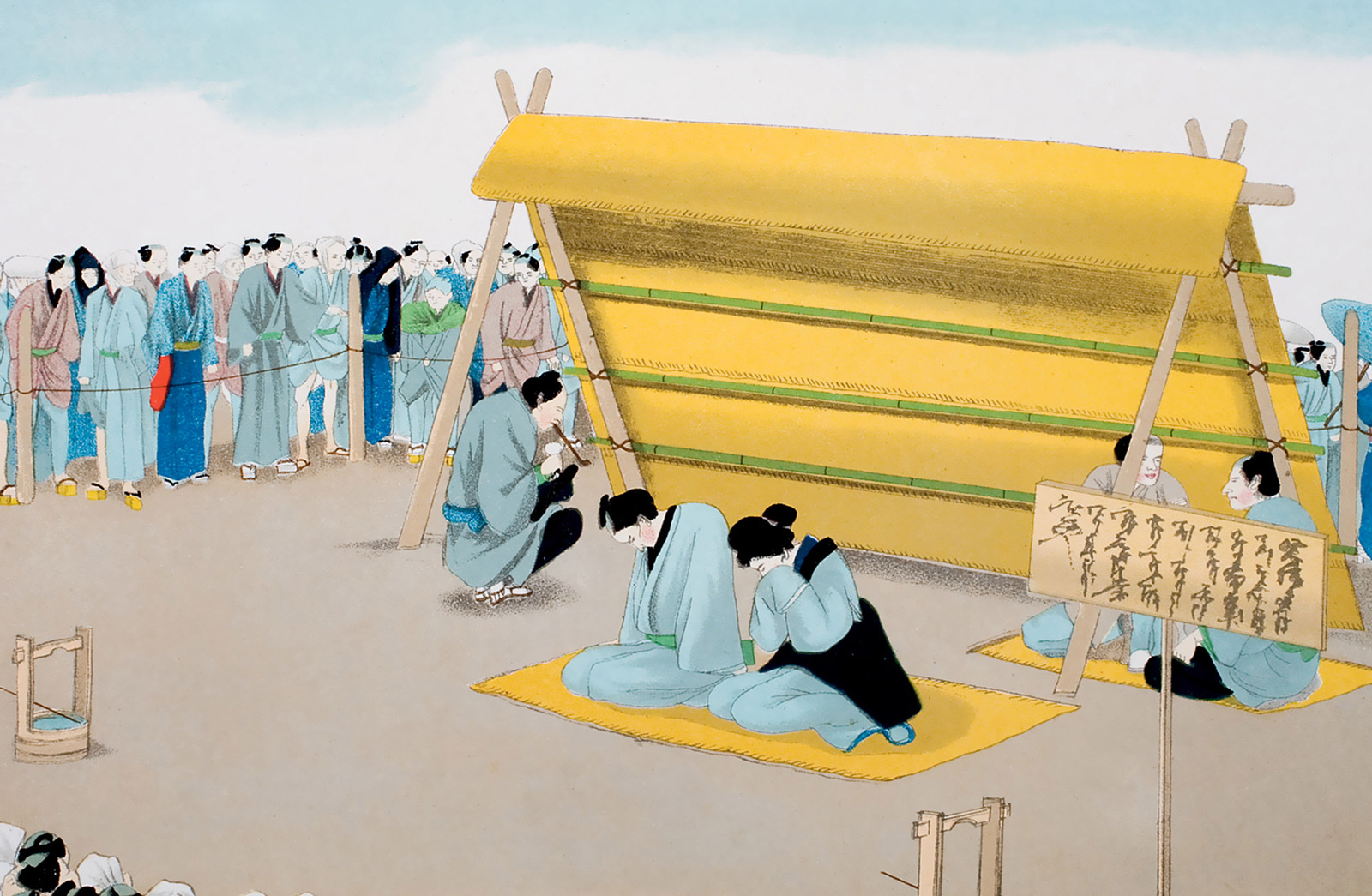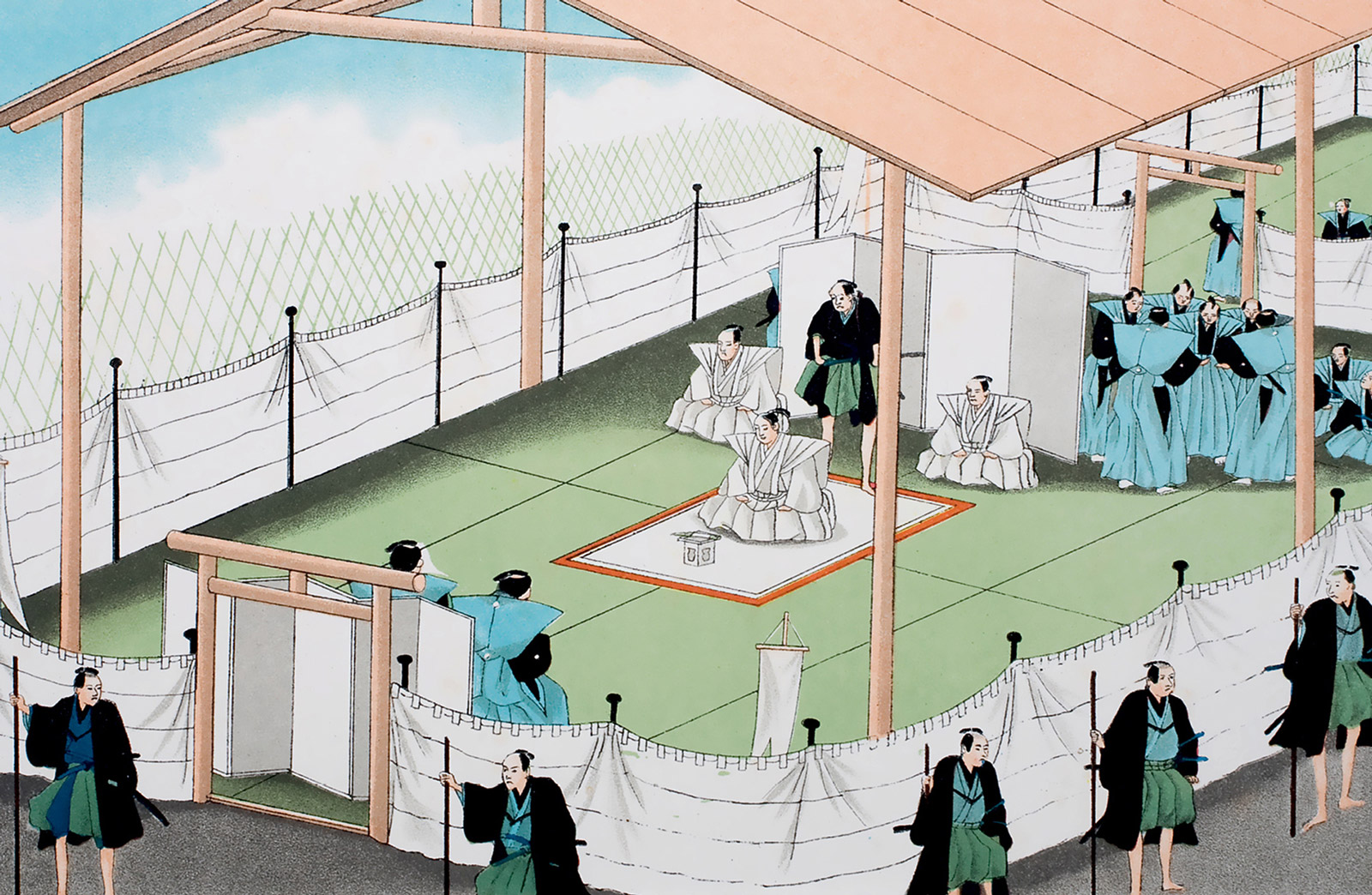Benedict’s Shame
Translating the Chrysanthemum and the Sword
Marilyn Ivy
“Shame is the Cinderella of the unpleasant emotions,” wrote psychoanalyst Charles Rycroft in 1968, “having received much less attention than anxiety, guilt and depression.”[1] Certainly Freud and his European descendants, including Lacan, thought little of shame. Laplanche and Pontalis, for example, included no entry for “shame” in their inestimable Language of Psychoanalysis. Although this orphan child found a certain place in American psychoanalysis (think of Heinz Kohut and self psychology) and has experienced a resurgence in recent years, it still remains strangely unmoored there. Unlike psychoanalysis, however, anthropology has long provided a home for shame.
Social structure, kinship, material culture, aesthetics, political formations: all these are enduring objects of anthropology, but none seemed to shape the golden age of American cultural anthropology as much as the role of emotion in the formation of personality, writ both small and large, individual and cultural. Personality was imagined as an individual field of affects and emotions, structured by culture; culture was fantasized as a bloated expansion of a modal mini-personality. When personality and culture approach each other, two anthropologists inevitably come to mind: the redoubtable Margaret Mead (1901–1978) and the equally, if differently, formidable Ruth Benedict (1887–1948).[2]
Following Mead and Benedict, anthropologists imagined cultures as holistic unities, as aesthetic totalities, and as meta-personalities. Since culture operated as an inherited and transmissible template of prefab possibilities for subjects, individuals and their emotions would of course reflect the emotional repertoire of this elusively transcendental substance of “culture” in its myriad instantiations. From this viewpoint, cultural transmission occurred through child rearing—surprise!—and by studying this transmission in its psychological dimensions, key insights into the articulation of individual personality and cultural personality would emerge. This so-called “culture and personality” school of anthropology was thus profoundly psychological, if only fitfully psychoanalytic.
In 1934, Ruth Benedict’s Patterns of Culture emerged as an elegant and exotic explication of cultural difference.[3] The very notion of culture, as developed by German theorists from the eighteenth century on, already implied an aesthetic totality, a unity, a whole, even a personality, which could then be described by regularities and patterns. It was this dimension of German cultural theory that Franz Boas inherited and transmitted to the founding generation of American anthropologists. As an heir to this legacy, Benedict made entire worlds of difference conform to aesthetic comprehension by presenting cultures as patterned wholes. She found that the most powerful way to convey these patterned wholes was to portray poetically—mythically?—the dominant emotional regularities, affective values, and feeling tones of a people. Her explications were memorable. How many undergraduates still remember the grand distinction between Dionysian and Apollonian cultures (epitomized, for Benedict, by Kwakiutl Indian vs. Pueblo Indian societies) long after they have forgotten any of the other details purveyed in Anthropology 101? Indeed, Patterns of Culture is probably the most famous work of American anthropology, the one which both your grandmother and your nephew might have heard of, and might even have read.

But back to shame. Shame is one of those emotions (affects? feelings?) that American cultural anthropology took on, even when psychoanalysis proper had not found it central. And here comes Benedict again: not only is Patterns of Culture arguably the most famous work in American anthropology, her later The Chrysanthemum and the Sword: Patterns of Japanese Culture (note the subtitle!) is probably the most famous work, in any genre, ever written about Japan. It might also be the most famous anthropological work on shame, even though the pages devoted to shame are disappointingly few.
This book produced Japan as a “shame culture” for American delectation. Written during World War II by contract with the United States Office of War Information and published in 1946 after Japan’s atomic defeat, the book was formed through interviews with Japanese prisoners of war and Japanese-Americans (Benedict knew no Japanese and never went to Japan). The Chrysanthemum and the Sword’s mission was to explain to uncomprehending Americans the bizarreries of Japanese behavior, behavior that had led to such inexplicable extremities as kamikaze suicide bombings. Tacking back and forth from the antinomies of Japanese social life—the seeming incommensurable differences of “the most alien enemy the United States had ever fought in an all-out struggle”—to their rough American parallels, Benedict aimed to explicate the entire cultural personality of Japan.[4] In the process, Japan became America’s evil twin, yet one now open to Americanized rehabilitation in the midst of its ruined cities and nuclear ashes. Likewise, the United States became Japan’s good twin. The Chrysanthemum and the Sword is as much about the United States in its triumphal moment after the war as it is about Japan.
In this story of Japan (and the United States), shame plays a central role. Shame has a twin, too, in Benedict’s story: guilt. In her para-Freudian anthropology, Japan is a shame culture, America a guilt culture: “A society that inculcates absolute standards of morality and relies on men’s developing a conscience is a guilt culture by definition. … In a culture where shame is a major sanction … a man does not experience relief when he makes his fault public even to a confessor. So long as his bad behavior does not ‘get out into the world’ he need not be troubled. … True shame cultures rely on external sanctions for good behavior, not, as true guilt cultures do, on an internalized conviction of sin. … [Shame] requires an audience or at least a man’s fantasy of an audience. Guilt does not.”[5]
Ashamed, shame appears as less developed, less autonomous, less evolved than guilt. Shame is felt always in relation to the Other, unlike guilt with its sturdy, consistent standards of morality (guilt is confessable). Shame is more primitive. Shame allows the most heinous deeds, and all is well, as long as these crimes are not exposed to the gaze of the world. Guilt does not depend on crime’s revelation. Guilt is internalized, autonomous; shame is externalized, heteronomous. Guilt is fixed; shame is mutable. Guilt is American; shame is Japanese.
These twinned affects are not that easily disengaged from each other, psychoanalytically speaking. But no matter for Benedict. It was crucial to open up a split between shame and guilt in order to maintain a hierarchical difference between Japan and the United States, and indeed between the non-West and the West (guilt is a Judeo-Christian thing; non-Westerners wouldn’t understand). In understanding Japanese shame, Americans would understand as well the superiority of their guilt culture; through the immense labor of reconstruction demanded by the postwar Occupation, the occupiers would help Japan comprehend the shame of its shame culture, ensuring its future sublation as an Americanized ally with imported democratic values, mass cultural pleasures, and the proprieties of guilt.
What was unanticipated was the tremendous impact The Chrysanthemum and the Sword would have in Japan itself. Translated into Japanese almost immediately after its American publication, the book has been one of the most important influences on Japanese social psychology and native ethnology in the postwar period: millions of copies have been sold and high school textbooks quote from it.[6] It seems that many Japanese found the aesthetico-cultural totalities served up by Benedict as comforting as Americans did: this is who (we) Japanese are! Indeed, Benedict’s book was indispensable to homegrown cultural theorists who keenly felt the shame of Japan’s defeat, its postwar international isolation and dependence on American largesse. Benedict’s orientalist tract was recuperated not only as actually descriptive of the truth of Japanese culture (itself a notion overdetermined by Japanese prewar fascism and its philosophers of empire—Benedict got many of her ideas about Japan from prisoners of war who had been thoroughly inculcated with the social rules of the wartime emperor system), but also as empowering in its rendering of social life by a series of easily grasped dichotomies. The Chrysanthemum and the Sword provided a persuasive explanation of why the West couldn’t understand Japan, and Japan’s shame—here transformed into a point of national pride—was at its base. A culturalist explanation, as proffered by Benedict, allowed the Japanese to claim something ineffable and essential about their “national character,” as the term went. That ineffable something called “shame” became a fetishized point of identification, a mark of dramatic difference from the conquering Americans. Even if a shame culture was clearly not as advanced as a guilt culture in Benedict’s cultural calculus, shame could nevertheless be claimed, stubbornly and defiantly, as a crucial part of the “national thing,” that ineluctable “thing” which, by definition, cannot be understood by outsiders. The “Japanese thing,” as developed by mass media, education, cultural critics, and the state alike, bears witness to the peculiar force of Benedict’s shame and its continuing afterlife.[7]


Not all Japanese were taken by Benedict’s book, though, and the critical response over the years has been fierce. Benedict had no notion of class; she mistook the ruling ideology for the everyday beliefs of the people; she didn’t know what capitalism was; her drive to conceive of a modern nation-state as a timeless culture led her to ignore processes and possibilities of historical change; her incessant tabulation and dichotomization of values led to an impoverished, simplistic view of Japan; her investment in aesthetic totalization caused her to ignore plurality and difference; her belief in the superiority of Western values led her to categorize, however slyly, non-Western ones as lesser; she imagined Japan as the dyad of the United States, while ignoring Japan’s imperialism in the rest of Asia; she didn’t know from shame; she was simply orientalist: these are some of the innumerable lapses that Japanese critics—folklorists, political theorists, philosophers, literary scholars, anthropologists—have detected over the years. Benedict’s book still flourishes in Japan, however, somehow impervious to these irrefutable criticisms. Shame and its accompaniments are not that easily relinquished, it seems, and to hold on to the specificity of a culture of shame is to retain a negative difference from that guilt-ridden Americanism, that now, more than ever, would dominate the world with its imperial ambitions.
Yet the Japanese state, too—despite the so-called culture of shame—shows no shame in its unwillingness to acknowledge the atrocities of the war (the “previous war”—saki no sensō, as it is called in Japanese), through apology to its victims (apology is an admission of wrongdoing) or otherwise. In the kindly, conquering language of anthropological toleration, The Chrysanthemum and the Sword allowed the Japanese to forget their own colonizing and militaristic endeavors through the locked duality of the American embrace. With a logic that borders on the perverse, Benedict’s tract provided a strange culturalist alibi for the forgetting of wartime atrocity. By arguing that the notion of “shame” could describe an entire culture, and that culture itself could account for the ethico-political actions of a modern nation-state, Benedict let the Japanese off the historical hook. In short, in Benedict’s world, the Japanese aren’t ethically responsible for wartime atrocities or their colonization of Asia because they belong to a shame culture, in which one feels no responsibility towards those outside one’s social world: national-cultural Others don’t count (a Japanese proverb states that “The traveler knows no shame”). One feels no shame towards those who don’t belong to one’s social world, and if the Japanese feel no shame for wartime atrocities committed outside of Japan, it’s because of their culture. Who can argue against that? Benedict’s notion of a culture of shame, and more fundamentally her notion of culture itself, is an essentialist explanation for Japanese behavior: the analytical buck stops there.
Haji is the Japanese term that Benedict rendered as “shame.” Benedict’s shame, and anthropology’s, was to think that producing patterns of culture could take the place of political analysis, that “shame” could translate haji transparently, without remainders, and that there was a “proper place” (a translated expression used throughout The Chrysanthemum and the Sword) for shame, a place called Japan. But shame can’t be kept apart from its guilty twin, and the improprieties of their commingling (like those of the chrysanthemum and the sword) disclose that shame can’t be the special property of a place called Japan, a “shame culture.” Japanese shame existed only in translated relation to American guilt, emerging in the midst of Japan’s failed empire and war defeat. But shame has no proper place as it moves between the United States and Japan, as it crosses into guilt and back again, and as it circulates globally (Benedict’s notion of shame and guilt cultures spawned endless anthropological attempts to categorize world cultures in a similar fashion; not surprisingly, most non-Western cultures came to be placed at the shame end of the spectrum). If today, shame-in-general remains an affective orphan, a psychoanalytic Cinderella, Benedict’s shame, itself a wartime child of the ashes, found its (im)proper place in the twinnings of Japan and America, of psychology and anthropology, of war crimes and postwar amnesia. The Chrysanthemum and the Sword discloses that shame has an uncanny home, not in Japan itself (as Benedict claimed) or any other place as such, but furtively, in between: in between social subjects (Benedict’s shame is always relational and situational, unlike guilt), between languages, and between nations. Anthropology today—unlike Benedict’s anthropology of 1946—must take on shame in that furtive place of the in-between; to do so would release shame from its confinement to any particular location, Japan or otherwise. Benedict’s shame might then come to its long-anticipated end.
- Charles Rycroft, Critical Dictionary of Psychoanalysis (London: Penguin, 1968), p. 152.
- Mead and Benedict were both students of Franz Boas (1858–1942), the so-called founder of American anthropology and, in 1897, the founder of the Department of Anthropology at Columbia University, the discipline’s first Ph.D.-granting department in the United States.
- Ruth Benedict, Patterns of Culture (Boston: Houghton Mifflin Company, 1934).
- Ruth Benedict, The Chrysanthemum and the Sword: Patterns of Japanese Culture (Boston: Houghton Mifflin Company, 1946), p. 1.
- The Chrysanthemum and the Sword, op. cit., pp. 222–223.
- See C. Douglas Lummis, “Ruth Benedict’s Obituary for Japanese Culture,” Japan Focus, available at www.japanfocus.org/-C.%20Douglas-Lummis/2474, and Sonia Ryang, “Chrysanthemum’s Strange Life: Ruth Benedict in Postwar Japan,” Asian Anthropology, no. 1 (2002), pp. 87–116.
- See Slavoj Zizek, “Eastern Europe’s Republics of Gilead,” New Left Review, no. 183 (September–October 1990), pp. 50–62. “Mode of Conducting a Criminal to Execution,” from Sketches of Japanese Manners and Customs by J. M. W. Silver, 1867. The culprit is paraded through town preceded by a placard describing his crime. Silver, a lieutentant in Britain’s Royal Marines, collected “native drawings” for his book during military service in Japan in 1864–1865. “Exposure for Infidelity,” from Sketches of Japanese Manners and Customs.
Marilyn Ivy teaches anthropology at Columbia University. She is the author of Discourses of the Vanishing: Modernity, Phantasm, Japan (University of Chicago Press, 1995) and has published widely on themes ranging from the obsession with missing children in the United States to the place of Buddhism in late modernity. Her recent work has focused on the complex political and aesthetic agendas that have shaped “Superflat” art in contemporary Japan.